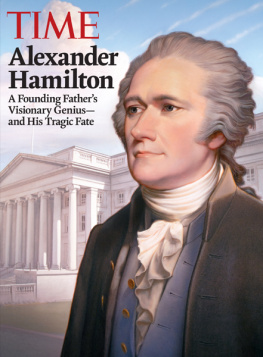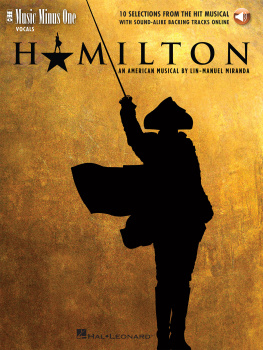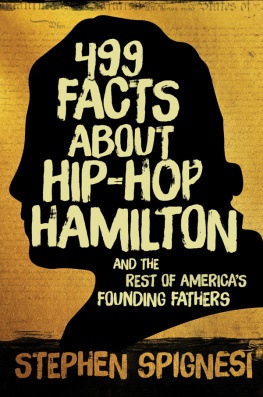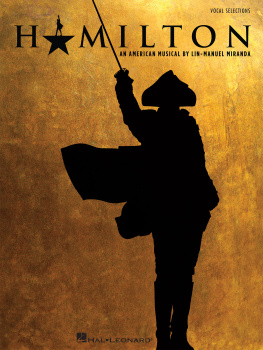Historians on Hamilton

Historians on Hamilton
How a Blockbuster Musical Is Restaging Americas Past
Edited by
Renee C. Romano and Claire Bond Potter

RUTGERS UNIVERSITY PRESS
NEW BRUNSWICK, NEWARK, AND CAMDEN, NEW JERSEY, AND LONDON
Library of Congress Cataloging-in-Publication Data
Names: Romano, Renee Christine. | Potter, Claire Bond, 1958
Title: Historians on Hamilton : how a blockbuster musical is restaging America / edited by Renee C. Romano and Claire Bond Potter.
Description: New Brunswick : Rutgers University Press, [2018] | Includes bibliographical references and index.
Identifiers: LCCN 2017033851| ISBN 9780813590301 (cloth : alk. paper) | ISBN 9780813590295 (pbk. : alk. paper)
Subjects: LCSH: Miranda, Lin-Manuel, 1980- Hamilton. | Hamilton, Alexander, 1757-1804.
Classification: LCC ML410.M67976 H57 2018 | DDC 782.1/4dc23
LC record available at https://lccn.loc.gov/2017033851
A British Cataloging-in-Publication record for this book is available from the British Library.
This collection copyright 2018 by Rutgers, The State University Individual chapters copyright 2018 in the names of their authors
All rights reserved
No part of this book may be reproduced or utilized in any form or by any means, electronic or mechanical, or by any information storage and retrieval system, without written permission from the publisher. Please contact Rutgers University Press, 106 Somerset Street, New Brunswick, NJ 08901. The only exception to this prohibition is fair use as defined by U.S. copyright law.
 The paper used in this publication meets the requirements of the American National Standard for Information SciencesPermanence of Paper for Printed Library Materials, ANSI Z39.481992.
The paper used in this publication meets the requirements of the American National Standard for Information SciencesPermanence of Paper for Printed Library Materials, ANSI Z39.481992.
www.rutgersuniversitypress.org
Manufactured in the United States of America
Contents
RENEE C. ROMANO AND CLAIRE BOND POTTER
WILLIAM HOGELAND
JOANNE B. FREEMAN
LYRA D. MONTEIRO
LESLIE M. HARRIS
CATHERINE ALLGOR
MICHAEL OMALLEY
DAVID WALDSTREICHER AND JEFFREY L. PASLEY
ANDREW M. SCHOCKET
ELIZABETH L. WOLLMAN
BRIAN EUGENIO HERRERA
JIM CULLEN
PATRICIA HERRERA
JOSEPH M. ADELMAN
RENEE C. ROMANO
CLAIRE BOND POTTER
JIM CULLEN
Historians on Hamilton
RENEE C. ROMANO AND CLAIRE BOND POTTER
America has gone Hamilton crazy. Lin-Manuel Mirandas musical about Alexander Hamilton, the forgotten founding father, was an unlikely subject for a Broadway hit. But it has become a widely acknowledged turning point in American theater history. Since it first opened Off-Broadway on January 20, 2015, at the Public Theater, Hamilton: An American Musical has been showered with recognition. Nominated for an unprecedented sixteen Tony Awards, it won eleven, as well as a Grammy, a Pulitzer, and eight Drama Desk Awards. It has become a cultural, political, and historical phenomenon with such widespread appeal that, as Time magazine reported in the fall of 2016, not only were children demanding Hamilton-themed birthday parties and Halloween costumes, but adults were also incorporating lines from the show into their wedding vows.
History is happening in Manhattan, the cast sings exuberantly in Act I, as the Schuyler sisters sneak downtown in search of the American Revolution and a mind at work. But these words also resonate with the work taking place every night on the stage of the Richard Rodgers Theatre. Hamilton is making history, and its impact is being felt well beyond the rarefied haunts of Broadway. History teachers are picking up on their students enthusiasm to spice up their courses, books about the American Revolution are flying off the shelves, heritage sites associated with Alexander Hamilton are experiencing heavy traffic, and the catchy lyrics seem almost universally

The marquee at the Richard Rodgers Theater, where Hamilton has been playing since it opened on Broadway in August 2015. (EQRoy/Shutterstock.com)
Instead of going to the Weehawken Institute to manage our symptoms, as the video suggests, we decided to treat our Hamilaria by editing a volume of essays that would help students and fans dig more deeply into the show. While Hamiltons popularity is ripe fodder for satire, theres no denying a critical and commercial success that is sparking a burst of popular interest in early American history, conversations among teachers about how to capitalize on Hamiltons popularity with young people, and lively disagreements among scholars, curators, and history buffs about how the show represents the national past.
For those who have perhaps lived without television, radio, the Internet, or media of any kind for the past few years, the musical draws on Ron Chernows 2005 Pulitzer Prizewinning popular biography, Alexander Hamilton, to bring this lesser-known founder out of the shadows. The musical begins with our heros arrival in New York from the West Indies as a young man, traces his service in the American Revolution, his accomplishments as the first Treasury secretary under President George Washington, and his involvement in what may be the nations first sex scandal. The musical ends with Hamiltons early death in a duel at the hands of fellow founder and vice president Aaron Burr. Both a political tale and a character study, the musical seeks to get inside the head of an ambitious and sometimes ruthless man, famously obsessed with making his mark on history, to understand his spectacular rise and fall.
But it is less the story than the means of telling it that has won Hamilton such attention and acclaim. The brainchild of Lin-Manuel Miranda, a New Yorker who grew up in the Inwood section of Manhattan and who spent summers with his grandparents in Vega Alta, Puerto Rico, the show is, in his words, a story about America then, told by America now. It draws on musical traditions from hip hop, to rap, to R&B in order to convey the energy, ambition, and drive of the young founders, artistic choices that have made its score catchy, quotable, and singable. And perhaps most attention grabbing, young black, Latinx, and Asian actors portray nearly all of the historically white characters depicted in the musical, reflecting Mirandas goal to have the staging of this national founding story look the way our country looks.
As an ever more multiracial America struggles for ways to acknowledge its diversity in the twenty-first century and, simultaneously, articulate a sense of American identity, Hamilton literally stages that conversation. Often described as Mirandas most daring decision, the flipped casting challenges Broadways long history of using whites to play black, Asian, and Latinx roles, offering people of color an Whether truly revolutionary or nota subject that several essays in this volume considerHamiltons traditional political story, told through Afro-Caribbean music and by a multiracial cast, has seemed to capture the political zeitgeist of the Age of Obama.
And its captured the cultural zeitgeist as well. From the moment it opened Off-Broadway, Hamilton has earned raves from critics, fans, and even some historians. Since the revised show opened on Broadway in August 2015, it has broken records of every kind: for the highest-grossing weekly box office for any show in Broadway history ($3.3 million for the performance of eight shows in November 2016), to the most Tony nominations for a single show (sixteen;
Next page









 The paper used in this publication meets the requirements of the American National Standard for Information SciencesPermanence of Paper for Printed Library Materials, ANSI Z39.481992.
The paper used in this publication meets the requirements of the American National Standard for Information SciencesPermanence of Paper for Printed Library Materials, ANSI Z39.481992.